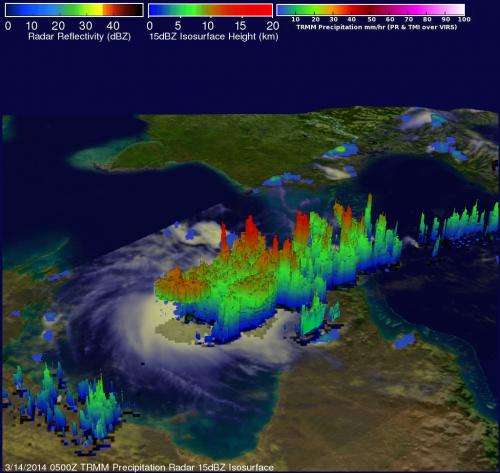TRMM satellite eyeing Tropical Cyclone Gillian's rebirth

Heavy rainfall rates and powerful towering thunderstorms were spotted in what appeared to be the rebirth process of Tropical Cyclone Gillian in the Gulf of Carpentaria between Australia's Northern Territory and Queensland.
The Tropical Rainfall Measuring Mission satellite called TRMM flew above northern Australia on March 14, 2014 at 0500 UTC/1 a.m. EDT capturing rainfall data. Very strong convective storms in this area are the remnants of tropical cyclone Gillian and may signal a rebirth. TRMM's Precipitation Radar (PR) instrument found rain falling at the rate of over 116 mm/4.5 inches per hour in these powerful storms in the northeastern Gulf of Carpentaria.
TRMM PR data were also used to create a 3-D view of the strong convective storms in the northern Gulf of Carpentaria. Some towering convective storms were found to be very energetic. Several tall storms were shown to reach altitudes greater than 16.75 km/10.4 miles. Some heavy rain within these storms returned reflectivity values greater than 52dBZ to the satellite. TRMM is a joint satellite mission of NASA and the Japan Aerospace Exploration Agency.
Animated multispectral satellite imagery today, March 16, showed a system that has become more symmetric. The Joint Typhoon Warning Center noted on March 14 at 01:40 UTC, that a composite radar loop from Weipa showed formative bands of thunderstorms had begun to spiral into a low level circulation center that has become better defined.
Computer models indicate that Ex-Tropical Cyclone Gillian will re-intensify to at least 35 knots/40 mph/62 kph over the next 24 to 36 hours. Maximum sustained surface winds are estimated at 25 to 30 knots/ 28.7 to 34.5 mph/46.3 to 55.5 kph. Minimum sea level pressure is estimated to be near 1001 millibars.
The Australian Bureau of Meteorology has posted a warning and a watch for Ex-Tropical Cyclone Gillian. A Cyclone Warning continues for coastal and island communities from Elcho Island to Numbulwar, including Alyangula and Nhulunbuy. A Cyclone Watch continues for coastal areas from Croker Island to Elcho Island.
The warning stated that Gillian is expected to approach the coast near Nhulunbuy early Sunday (March 16) morning then continue heading west near the northern coast of the Top End.
Residents between Numbulwar and Nhulunbuy, including Alyangula can expect gusty winds today, March 14, and those conditions will spread west on March 16. In addition to the winds, heavy rainfall, higher than normal tides and large waves will accompany Gillian as it moves west.
The Australian Bureau of Meteorology expects Gillian's remnants to meander in the Gulf of Carpentaria for the next day before setting course to the northwest and moving past Nhulumbuy and Elcho Island, Northern Territory on March 16 and 17. For updated watches and warnings, visit: http://www.bom.gov.au/cyclone.
Provided by NASA's Goddard Space Flight Center



















